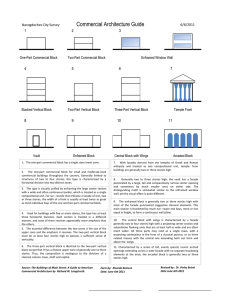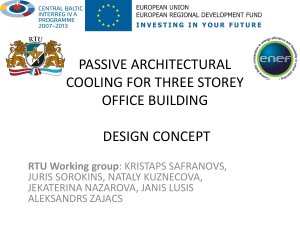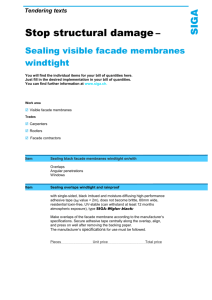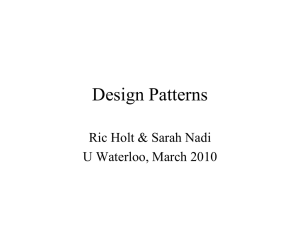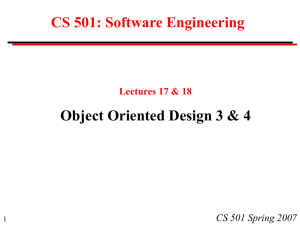DETERMINATION OF FACADE ATTRIBUTES FOR FACADE RECONSTRUCTION
advertisement
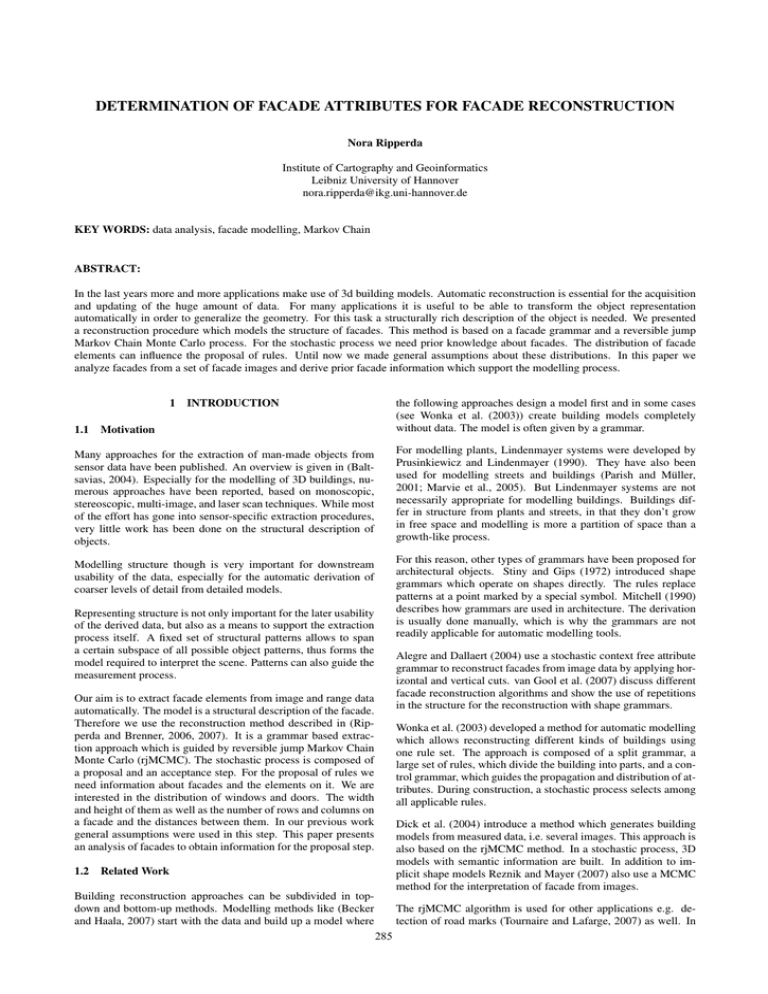
DETERMINATION OF FACADE ATTRIBUTES FOR FACADE RECONSTRUCTION
Nora Ripperda
Institute of Cartography and Geoinformatics
Leibniz University of Hannover
nora.ripperda@ikg.uni-hannover.de
KEY WORDS: data analysis, facade modelling, Markov Chain
ABSTRACT:
In the last years more and more applications make use of 3d building models. Automatic reconstruction is essential for the acquisition
and updating of the huge amount of data. For many applications it is useful to be able to transform the object representation
automatically in order to generalize the geometry. For this task a structurally rich description of the object is needed. We presented
a reconstruction procedure which models the structure of facades. This method is based on a facade grammar and a reversible jump
Markov Chain Monte Carlo process. For the stochastic process we need prior knowledge about facades. The distribution of facade
elements can influence the proposal of rules. Until now we made general assumptions about these distributions. In this paper we
analyze facades from a set of facade images and derive prior facade information which support the modelling process.
1
1.1
INTRODUCTION
the following approaches design a model first and in some cases
(see Wonka et al. (2003)) create building models completely
without data. The model is often given by a grammar.
Motivation
For modelling plants, Lindenmayer systems were developed by
Prusinkiewicz and Lindenmayer (1990). They have also been
used for modelling streets and buildings (Parish and Müller,
2001; Marvie et al., 2005). But Lindenmayer systems are not
necessarily appropriate for modelling buildings. Buildings differ in structure from plants and streets, in that they don’t grow
in free space and modelling is more a partition of space than a
growth-like process.
Many approaches for the extraction of man-made objects from
sensor data have been published. An overview is given in (Baltsavias, 2004). Especially for the modelling of 3D buildings, numerous approaches have been reported, based on monoscopic,
stereoscopic, multi-image, and laser scan techniques. While most
of the effort has gone into sensor-specific extraction procedures,
very little work has been done on the structural description of
objects.
For this reason, other types of grammars have been proposed for
architectural objects. Stiny and Gips (1972) introduced shape
grammars which operate on shapes directly. The rules replace
patterns at a point marked by a special symbol. Mitchell (1990)
describes how grammars are used in architecture. The derivation
is usually done manually, which is why the grammars are not
readily applicable for automatic modelling tools.
Modelling structure though is very important for downstream
usability of the data, especially for the automatic derivation of
coarser levels of detail from detailed models.
Representing structure is not only important for the later usability
of the derived data, but also as a means to support the extraction
process itself. A fixed set of structural patterns allows to span
a certain subspace of all possible object patterns, thus forms the
model required to interpret the scene. Patterns can also guide the
measurement process.
Alegre and Dallaert (2004) use a stochastic context free attribute
grammar to reconstruct facades from image data by applying horizontal and vertical cuts. van Gool et al. (2007) discuss different
facade reconstruction algorithms and show the use of repetitions
in the structure for the reconstruction with shape grammars.
Our aim is to extract facade elements from image and range data
automatically. The model is a structural description of the facade.
Therefore we use the reconstruction method described in (Ripperda and Brenner, 2006, 2007). It is a grammar based extraction approach which is guided by reversible jump Markov Chain
Monte Carlo (rjMCMC). The stochastic process is composed of
a proposal and an acceptance step. For the proposal of rules we
need information about facades and the elements on it. We are
interested in the distribution of windows and doors. The width
and height of them as well as the number of rows and columns on
a facade and the distances between them. In our previous work
general assumptions were used in this step. This paper presents
an analysis of facades to obtain information for the proposal step.
1.2
Wonka et al. (2003) developed a method for automatic modelling
which allows reconstructing different kinds of buildings using
one rule set. The approach is composed of a split grammar, a
large set of rules, which divide the building into parts, and a control grammar, which guides the propagation and distribution of attributes. During construction, a stochastic process selects among
all applicable rules.
Dick et al. (2004) introduce a method which generates building
models from measured data, i.e. several images. This approach is
also based on the rjMCMC method. In a stochastic process, 3D
models with semantic information are built. In addition to implicit shape models Reznik and Mayer (2007) also use a MCMC
method for the interpretation of facade from images.
Related Work
Building reconstruction approaches can be subdivided in topdown and bottom-up methods. Modelling methods like (Becker
and Haala, 2007) start with the data and build up a model where
The rjMCMC algorithm is used for other applications e.g. detection of road marks (Tournaire and Lafarge, 2007) as well. In
285
The International Archives of the Photogrammetry, Remote Sensing and Spatial Information Sciences. Vol. XXXVII. Part B3a. Beijing 2008
S YMMETRIC FACADE M IDDLE is partitioned further in two FA CADE E LEMENT s, the lower one contains a D OOR and the upper
one consists of an I DENTICAL A RRAY which means that the attached elements (in this case W INDOWs) are all of the same kind.
general rjMCMC is a top-down-approach, but Tu et al. (2005) integrated generative and discriminative methods and used a data
driven MCMC (DDMCMC) for image parsing. In (Ripperda and
Brenner, 2007) a data driven extension of an rjMCMC based facade reconstruction method is shown.
2
The facade grammar consists of different kinds of symbols. The
start symbol is the bare facade which knows only about the outline of the facade. Other nonterminal symbols comprise structural
information like symmetries, repetitions and so on. These symbols can be divided in other nonterminals or in terminal symbols
like W INDOW or D OOR.
FACADE RECONSTRUCTION BASED ON A
FORMAL GRAMMAR AND RJMCMC
In this section the reconstruction method is shortly presented.
First the facade grammar which defines the facade model is introduced and then the reconstruction by rjMCMC is shown.
2.1
During the derivation process the facade model is developed. It
is defined by a parameter vector θ which contains the derivation
tree and the attributes of the symbols.
Facade Grammar
For facade reconstruction we define a grammar which gives possible models of the facade whereat the model describes the structure of the facade. The modelling process based on this grammar
corresponds to the derivation of a word of the grammar.
2.2
Facade Reconstruction using rjMCMC
The grammar provides many different models unrelated to the
scan and image data. But in the reconstruction process we search
for the best matching model for that data. Therefore we use a
stochastic process. Markov Chain Monte Carlo Methods help to
find the model (given by parameter vector θ) with the highest
probability p(θ|DS DI ) under given scan (DS ) and image data
(DI ).
In each step the model of the facade should be developed further. Therefore each grammar rule splits the left side symbol in a
variable number of symbols. So the derivation process is a partitioning process of the facade. The start symbol S is a blank facade
which is subdivided in further derivation steps.
To construct a Markov Chain that simulates a random walk in
the space of θ we have to define a transition kernel J(θt |θt−1 )
which assigns a probability to each change from one state θt−1
to another one θt . For the reconstruction these changes are given
by the rules of the facade grammar. With this kernel changes
are proposed and after that an acceptance probability decides if
the change is accepted. The acceptance probability is defined
in a way that the system converges to the target distribution
p(θ|DS DI ).
In this partitioning process a split can be caused by different reasons. The first reason is a difference in the facade structure. If
a facade contains different structural parts it is split into part facades according to the structure and each part is modelled individually in further derivation steps. This change in structure often
occurs in ground floor and upper floors, e.g. if shop windows are
located in the ground floor.
The other reason for a split is similarity or repetition. If a facade
is symmetric or contains repetitions, the repeated pattern needs
to be stored only once. Additional information like number of
repetitions complete the model.
In our case the dimension of θ changes during the process. This is
not possible in the basic MCMC method. Therefore we use rjMCMC which contains dimension changes of θ (jumps). The probability of a dimension change is added to the transition kernel.
For the rjMCMC process with target distribution p(θ|DS DI ) we
have to define a transition kernel J(θt |θt−1 ) and the acceptance
probability α.
α = min{1,
p(θt |DS DI ) · J(θt−1 |θt )
}
p(θt−1 |DS DI ) · J(θt |θt−1 )
This depends on the unknown distribution p(θt |DS DI ). Using
Bayes’ law, this is proportional to p(DS DI |θt ) · p(θt ), a product
of likelihood and prior of the facade. To obtain the likelihood
scoring functions based on depth and image data are used. The
prior is influenced by the alignment and extend of the elements
on the facade.
Results of the reconstruction are shown in fig. 2. The left facade
is subdivided in upper and lower part (green line) and the upper
part is modelled by an array of windows. The windows is the
right facade are modelled as a regular grid of pairs of windows.
Figure 1: Derivation example: a) Image of the sample facade,
b) partitioning of the facade according to the grammar rules, c)
resulting derivation tree.
3
As an example fig.1 shows an image of a facade (a) and an outlined subdivision (b) according to the rules of the facade grammar. The corresponding derivation tree is given in (c). The example facade is first declared as symmetric, so only the middle
part and one of the outer parts need to be modelled in the following steps. The outer part S YMMETRIC FACADE S IDE is modelled as an A RRAY with two kind of W INDOWs. The middle part
FACADE ANALYSIS
In this section the analysis of facade images is described. First the
dataset is presented. Then the grammar rules which need the information about facade properties are described and the required
distributions are mentioned. After that the calculated distributions are presented and their influence on the reconstruction process is examined.
286
The International Archives of the Photogrammetry, Remote Sensing and Spatial Information Sciences. Vol. XXXVII. Part B3a. Beijing 2008
Figure 5: Different grammar rules which need information about
facade parameters.
Figure 2: Results of the reconstruction process.
3.1
information we need depends on the grammar rules. In the following different rules are presented and the required parameters
are enumerated. Fig. 5 shows the four discussed grammar rules.
Data presentation
To get the information about facades we acquired about 400 photographs of facades in a residential area. The dwelling houses
have between two and six floors. Fig. 3 shows some examples.
The grammar rule FACADE → I DENTICAL A RRAY subdivides
the facade in a regular grid of cells which are supposed to contain the same element (see fig. 5 a); in general windows. The
I DENTICAL A RRAY possesses the parameters number of rows and
columns, distance between the rows and columns and position of
the array.
To instantiate windows in the array the grammar rule I DENTI CAL A RRAY → W INDOW WALL is used (see fig. 5 b). Here the
distribution of width and height of windows is needed. Additionally the ratio of width and height is used. For creating a D OOR
besides the distribution of with, height and the ratio of them, the
position relative to the facade is needed. FACADE E LEMENT →
D OOR WALL is the corresponding grammar rule (see fig. 5 c).
Furthermore the grammar symbols S HOP and D OORWAY can be
used.
Another kind of rule is the split rule FACADE → PART FACADE
PART FACADE where the split is based on the difference in the
colour of the ground floor and the upper floors (see fig. 5 d).
The idea of this rule is not to split by reason of the change in
colour but because of a change in the facade structure which often
come along with the colour change. Examples for the coincident
change in colour and structure are given in fig. 6. For this rule we
use the distribution of the position of colour changes in facades.
Figure 3: Example facade photographs.
In a first step the photos are rectified and then the properties are
labelled using ArcMAP. The facades outline and facade elements
like windows, doors or balconies are modelled. Fig. 4 shows two
manually labelled facades. If the facade has different colours or
projections like oriels these are modelled as well.
Figure 6: Example facades with different colours and different
structures in the ground floor and the upper floors.
3.3
Here the results of the facade analysis are presented. To get the
distribution of the facade parameters we calculate the histogram
of the values. Figs. 7 and 8 show the distribution of the width
and height of windows. The width of windows in the test area
lies between 0.3m and 1.9m and the majority of the height values
between 0.5m and 2.4m. In the reconstruction the ratio of both
attributes is important as well. This distribution is shown in fig.
9. The ratio ranges from 0.2 to 0.7 with its mode at 0.48.
Figure 4: Manually labelled facade models.
3.2
Facade analysis
Facade properties
In the reconstruction process one rule of the grammar is chosen
and subsequently the parameters of the rule have to be proposed.
Therefore we need to know about the distribution of facade elements, the width and height of windows and doors, the number
of rows and columns on a facade and their average distance. The
The analysis also provides the different kinds of windows. Fig.
10 lists all occurring window types of the test data set. Window
287
The International Archives of the Photogrammetry, Remote Sensing and Spatial Information Sciences. Vol. XXXVII. Part B3a. Beijing 2008
0,09
0,08
0,07
0,06
0,05
0,04
0,03
0,02
0,01
1,95
1,85
1,75
1,65
1,55
1,45
1,35
1,25
1,15
1,05
0,95
0,85
0,75
0,65
0,55
0,45
0,35
0,25
0,15
0,05
0
Figure 7: Distribution of window width.
Figure 10: Different types of windows that occur in the test data
set.
0,07
0,06
0,05
0,35
0,04
0,03
0,30
0,02
0,25
0,01
0,20
0,00
0,05
0,20
0,35
0,50
0,65
0,80
0,95
1,10
1,25
1,40
1,55
1,70
1,85
2,00
2,15
2,30
2,45
2,60
2,75
2,90
3,05
3,20
3,35
3,50
3,65
3,80
3,95
0,15
0,10
Figure 8: Distribution of window height.
0,05
type 17 is a bricked window. Fig. 11 shows how frequent each
window type occours. The most frequent windows are windows
of type 1, 3 and 7. Window types 10 and 11 are very rare with
1,36%.
0,00
1
2
3
4
5
6
7
8
9 10 11 12 13 14 15 16 17
Figure 11: Histogram of different window types in the test data
set.
For the reconstruction of window grids the number of rows and
columns in a facade is important. Fig. 12 shows the distribution
of these values. The facades in the test dataset have between two
and eight rows where five is the most frequent number of rows.
The number of columns lies between three and ten with a mode
at six.
columns vary much more per facade than the distances of rows.
The blue line for the rows has a peak at zero and the maximal
value is 0.48m where the highest deviation for the columns (red
line) is 1.0m. Fig. 16 shows a histogram of the deviation of window height and width within a row or column. It shows that most
deviations are below 5cm.
After the number of rows and columns is defined in the reconstruction process the distance between them was determined.
Therefore the distribution of the distance of rows and columns
is used (see figs. 13 and 14). The distances between rows range
from 0.2m to 3.8m with a mode at 1.6m. For columns the distances lie between 1m and 5m with a mode at 3.3m.
For the placement of facade elements like D OOR, S HOP and
D OORWAY or the split line between ground floor and upper floors
fig. 17 shows the ratio of facades containing zero to three elements of each type. We also analyse the distributions of the parameter or these elements. The following three figures (figs. 18,
19 and 20) show histograms of the width, height and the ratio of
width and height of doors.
The analysis of the distance between rows and columns gives additional information for the reconstruction. The plot of the histograms of the standard deviations of the distances between rows
and columns of one facade in fig. 15 shows that the distances of
0,07
0,45
0,06
0,40
0,35
0,05
0,30
0,04
0,25
0,03
0,20
0,02
0,15
0,10
0,01
0,05
number of rows
0,00
0,75
0,72
0,69
0,66
0,63
0,60
0,57
0,54
0,51
0,48
0,45
0,42
0,39
0,36
0,33
0,30
0,27
0,24
0,21
0,18
0
1
Figure 9: Distribution of the ratio of window width to window
height.
2
3
4
5
6
7
8
9
10
number of columns
Figure 12: Distribution of the number of rows (blue) and columns
(red).
288
The International Archives of the Photogrammetry, Remote Sensing and Spatial Information Sciences. Vol. XXXVII. Part B3a. Beijing 2008
0,050
0,50
0,045
0 45
0,45
0,040
0,40
0,035
0,35
0,030
0,30
0,025
0,25
0,020
0,20
0,015
0 15
0,15
0,010
0,10
deviation of window height within a row
0,05
0,005
deviation of window width within a column
0,44
0,40
0,36
0,32
0,28
0,24
0,20
0,16
0,12
0,08
0,00
4,25
4,05
3,85
3,65
3,45
3,25
3,05
2,85
2,65
2,45
2,25
2,05
1,85
1,65
1,45
1,25
1,05
0,85
0,65
0,45
0,25
0,05
0,04
0,00
0,000
Figure 16: Histogram of the deviation of window hight (blue) or
width (red) within a row or column.
Figure 13: Distribution of the distance of rows.
0,050
0,045
1,0
0,040
0,9
0,035
0,8
0,030
0,7
0,025
0,6
3
0,5
2
0,010
0,4
1
0,005
0,3
0
0,000
0,2
0,020
0,05
0,30
0,55
0,80
1,05
1,30
1,55
1,80
2,05
2,30
2,55
2,80
3,05
3,30
3,55
3,80
4,05
4,30
4,55
4,80
5,05
5,30
5,55
5,80
0,015
0,1
0,0
Figure 14: Distribution of the distance of columns.
3.4
door
Test of the distributions
shop
doorway
split line
Figure 17: Relative number of facades containing 0, 1, 2 or 3
elements of a facade element or split line.
The derived distributions of facade parameters are integrated in
the grammar rules. Here the influence of the distribution of window width and height and the ratio between them is examined. In
the test one part of a facade with a single window is used. The
width and the height of the modelled window are changed by
the grammar rule. These changes are proposed in three different
ways.
and the missing parameter is calculated with a randomly sampled
ratio value.
Table 1 list the percentage of the proposals with nearly correct
width and height values. It is not important to hit the correct values exactly at the first try because change operations can move the
values to the correct solution in further steps if the value is near
the correct solution. The number of correct proposals in the tests
2 and 3 which are based on the distribution of facade parameters
is clearly larger than the one in test 1 without the distributions.
The numbers for test 3 including all distributions are a little better than the numbers for test 2 only including the ratio of width
and height.
The first test propose one of the values for width and height randomly from the previous value. Here a normal distribution is
used. The other value is calculated by a randomly proposed ratio.
This is assumed uniformly distributed from 0.5 to 2.0.
The second test uses the determined distribution of the ratio of
width and height. By random one of the parameters width and
height is chosen and the value is changed by sampling from the
normal distribution with the previous value as mean. Then the
ratio is sampled from the distribution of the ratio of width and
height and the missing parameter is calculated.
If we look at the acceptance rate of both tests (see tab. 2) test 2
shows a higher acceptance rate for both scoring methods. So we
propose to use the distribution of window width and height and
the ratio of them for the instantiation of a window and to use only
the ratio for the changing of window size.
In the last test width or height are sampled from the derived distributions as well. Again randomly width or height are chosen
0,40
0,35
0,16
0,30
0,14
0,25
0,12
0,20
0,10
0,15
0,08
0,06
0,10
deviation of distances between rows
0,02
deviation of distances between columns
Figure 15: Histogram of the standard deviations of the distances
between columns and rows per facade.
Figure 18: Histogram of width of doors.
289
3,00
2,80
2,60
2,40
2,20
2,00
1,80
1,60
1,40
1,20
1,00
0,80
0,60
0,40
0,00
0,20
0,00
0,06
0,12
0,18
0,24
0,30
0,36
0,42
0,48
0,54
0,60
0,66
0,72
0,78
0,84
0,90
0,00
0,04
0,00
0,05
The International Archives of the Photogrammetry, Remote Sensing and Spatial Information Sciences. Vol. XXXVII. Part B3a. Beijing 2008
0,12
Colour Cluster
Depth Cluster
0,10
0,08
Test 2
97.51 %
98.26 %
Test 3
95.58 %
96.72 %
Table 2: Acceptance rate of test 2 and test 3.
0,06
Baltsavias, E. P., 2004. Object extraction and revision by image
analysis using existing geodata and knowledge: current status
and steps towards operational systems. ISPRS Journal of Photogrammetry and Remote Sensing 58, pp. 129–151.
0,04
0,02
6,00
5,70
5,40
5,10
4,80
4,50
4,20
3,90
3,60
3,30
3,00
2,70
2,40
2,10
1,80
1,50
1,20
0,90
0,60
0,30
0,00
0,00
Becker, S. and Haala, N., 2007. Refinement of building facades
by integrated processing of lidar and image data. In: Photogrammetric Image Analysis 2007.
Figure 19: Histogram of door heights.
Dick, A., Torr, P., Cipolla, R. and Ribarsky, W., 2004. Modelling
and interpretation of architecture from several images. International Journal of Computer Vision 60(2), pp. 111–134.
0,20
0,18
0,16
0,14
Marvie, J.-E., Perret, J. and Bouatouch, K., 2005. The fl-system:
a functional l-system for procedural geometric modeling. The
Visual Computer 21(5), pp. 329 – 339.
0,12
0,10
0,08
0,06
Mitchell, W. J., 1990. The Logic of Architecture : Design, Computation, and Cognition. Cambridge, Mass.: The MIT Press.
0,04
0,02
Parish, Y. and Müller, P., 2001. Procedural modeling of cities. In:
E. Fiume (ed.), ACM SIGGRAPH, ACM Press.
1,00
0,95
0,90
0,85
0,80
0,75
0,70
0,65
0,60
0,55
0,50
0,45
0,40
0,35
0,30
0,25
0,20
0,15
0,10
0,05
0,00
0,00
Figure 20: Histogram of the ratio of width and height of doors.
4
Prusinkiewicz, P. and Lindenmayer, A., 1990. The algorithmic
beauty of plants. New York, NY: Springer.
CONCLUSION AND OUTLOOK
Reznik, S. and Mayer, H., 2007. Implicit shape models, model
selection, and plane sweeping for 3d facade interpretation. In:
Photogrammetric Image Analysis 2007.
In this paper, we have presented an analysis of facade data. We
determine several facade parameter distributions which can be
used in the grammar rules of the reconstruction framework. This
framework combines the generation of artificial facade structures
using grammars, and the reconstruction of facades using rjMCMC. Compared to existing grammar-based approaches, we gain
the ability to reconstruct facades based on measurement data.
Compared to existing rjMCMC approaches, by using a grammar,
we obtain a hierarchical facade description and the ability to evaluate superstructures such as regularity and symmetry at an early
stage, i.e., before terminal symbols such as W INDOW are instantiated.
Ripperda, N. and Brenner, C., 2006. Reconstruction of faade
structures using a formal grammar and rjmcmc. In: K. Franke,
K.-R. Mller, B. Nickolay and R. Schfer (eds), Pattern Recognition, Proceedings of the 28th DAGM Symposium, pp. 750–
759.
Ripperda, N. and Brenner, C., 2007. Data driven rule proposal for grammar based faade reconstruction. In: Photogrammetric Image Analysis 2007, International Archives of Photogrammetry, Remote Sensing and Spatial Information Sciences, Vol. 36number 3/W49A, pp. 1–6.
One of the future tasks is to implement further facade elements
like the different window types shown in fig. 10. Additionaly
scoring functions for the rjMCMC process have to be defined for
the different types.
Stiny, G. and Gips, J., 1972. Shape Grammars and the Generative
Specification of Painting and Sculpture. Auerbach, Philadelphia, pp. 125–135.
Tournaire, O., P. N. and Lafarge, F., 2007. Rectangular road
marking detection with marked point processes. In: Photogrammetric Image Analysis 2007.
Acknowledgements This work was done within in the scope
of the junior research group “Automatic methods for the fusion,
reduction and consistent combination of complex, heterogeneous
geoinformation”, funded by the VolkswagenStiftung, Germany.
Tu, Z., Chen, X., Yuille, A. and Zhu, S., 2005. Image parsing:
Unifying segmentation, detection, and recognition. International Journal of Computer Vision 63(2), pp. 113–140.
References
van Gool, L., Zeng, G., van den Borre, F. and Müller, P., 2007.
Towards mass-produced building models. In: Photogrammetric Image Analysis 2007.
Alegre, F. and Dallaert, F., 2004. A probablistic approach to the
semantic interpretation of building facades. In: International
Workshop on Vision Techniques Applied to the Rehabilitation
of City Centers.
Colour Cluster
Depth Cluster
Test 1
0.85 %
0.85 %
Test 2
7.25 %
7.00 %
Wonka, P., Wimmer, M., Sillion, F. and Ribarsky, W., 2003.
Instant architecture. ACM Transaction on Graphics 22(3),
pp. 669–677.
Test 3
9.02 %
8.90 %
Table 1: Percentage of accepted proposals near the right solution.
290

